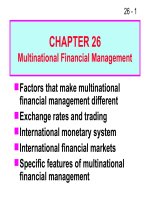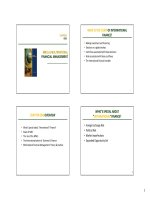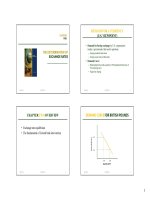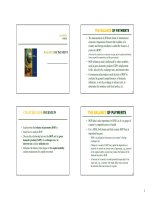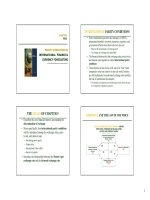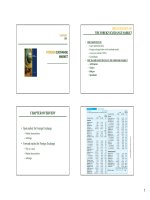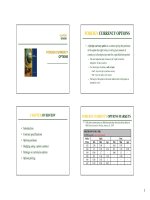Lecture Multinational financial management: Lecture 28 - Dr. Umara Noreen
Bạn đang xem bản rút gọn của tài liệu. Xem và tải ngay bản đầy đủ của tài liệu tại đây (947.73 KB, 22 trang )
Lecture
28
International Cash Management
Chapter Objectives
To explain the difference in
analyzing cash flows from a subsidiary
perspective versus a parent perspective;
To explain the various techniques used to
optimize cash flows;
To explain common complications in
optimizing cash flows; and
To explain the potential benefits and risks
of foreign investments.
21 - 2
Complications
in Optimizing Cash Flows
Company-related characteristics
¤
When a subsidiary delays its payments to
the other subsidiaries, the other
subsidiaries may be forced to borrow until
the payments arrive.
Government restrictions
¤
Some governments may prohibit the use of
a netting system, or periodically prevent
cash from leaving the country.
21 - 3
Complications
in Optimizing Cash Flows
Characteristics of banking systems
¤
¤
The abilities of banks to facilitate cash
transfers for MNCs may vary among
countries.
The banking systems in different countries
usually differ too.
21 - 4
Investing Excess Cash
• Excess funds can be invested in domestic
or foreign short-term securities, such as
Eurocurrency deposits, Treasury bills, and
commercial papers.
• Sometimes, foreign short-term securities
have higher interest rates. However, firms
must also account for the possible
exchange rate movements.
21 - 5
Short-Term Interest Rates
as of February 2004
21 - 6
Investing Excess Cash
Centralized Cash Management
• Centralized cash management allows for
more efficient usage of funds and possibly
higher returns.
• When multiple currencies are involved, a
separate pool may be formed for each
currency. Funds can also be invested in
securities that are denominated in the
currencies needed in the future.
21 - 7
Investing Excess Cash
Centralized Cash Management
• Given the current online technology,
MNCs should be able to efficiently create a
multinational communications network
among their subsidiaries to ensure that
information about their cash positions is
continually updated.
21 - 8
Investing Excess Cash
Determining the Effective Yield
• The effective yield on foreign investments
r = (1 + if )(1 + ef ) – 1
where if = the quoted interest rate on the
investment
ef = the % in the spot rate
• If the foreign currency depreciates over
the investment period, the effective yield
will be less than the interest rate.
21 - 9
21 - 10
Investing Excess Cash
Implications of Interest Rate Parity (IRP)
• A foreign currency with a high interest
rate will normally exhibit a forward
discount that reflects the differential
between its interest rate and the investor’s
home interest rate.
• However, short-term foreign investing on
an uncovered basis may still result in a
higher effective yield.
21 - 11
Investing Excess Cash
Use of the Forward Rate as a Forecast
• If IRP exists, the forward rate can be used
as a break-even point to assess the shortterm investment decision.
• The effective yield will be higher than the
domestic yield if the spot rate at maturity
is more than the forward rate at the time
the investment was undertaken.
21 - 12
Use of the Forward Rate as a Forecast
21 - 13
21 - 14
Investing Excess Cash
Use of Exchange Rate Forecasts
• Given an exchange rate forecast, the
expected effective yield of a foreign
investment can be computed, and then
compared with the local investment yield.
• It may be useful to use probability
distributions instead of point estimates, or
to compute the break-even exchange rate
that will equate foreign and local yields.
21 - 15
Investing Excess Cash
Deriving the Value of ef that Equates Foreign
and Domestic Yields
r = (1 + if )(1 + ef ) – 1
ef = (1 + r ) – 1
(1 + if )
• r = 11%, if = 14%
breakeven ef = -2.63%.
If the foreign currency depreciates by less
than 2.63%, the foreign currency deposit
will be more rewarding.
21 - 16
Use of Probability Distributions
21 - 17
21 - 18
Probability Distribution of Effective Yield
21 - 19
Investing Excess Cash
Diversifying Cash Across Currencies
• If an MNC is not sure of how exchange
rates will change over time, it may prefer
to diversify its cash among securities that
are denominated in different currencies.
• The degree to which such a portfolio will
reduce risk depends on the correlations
among the currencies.
21 - 20
Investing Excess Cash
Use of Dynamic Hedging to Manage Cash
• Dynamic hedging refers to the strategy of
hedging when the currencies held are
expected to depreciate, and not hedging
when they are expected to appreciate.
• The overall performance is dependent on
the firm’s ability to accurately forecast the
direction of exchange rate movements.
21 - 21
• Source: Adopted from SouthWestern/Thomson Learning © 2006
21 - 22
